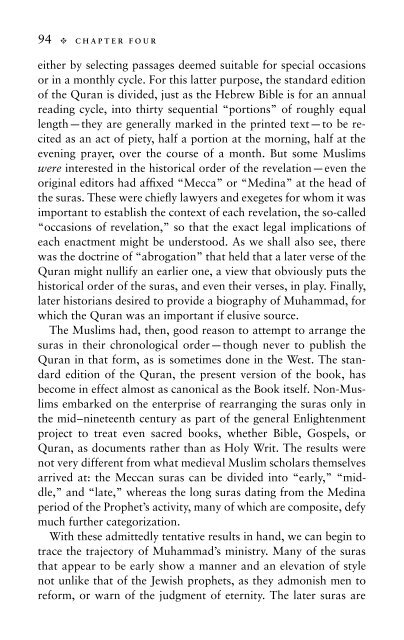Islam: A Guide for Jews and Christians - Electric Scotland
Islam: A Guide for Jews and Christians - Electric Scotland
Islam: A Guide for Jews and Christians - Electric Scotland
Create successful ePaper yourself
Turn your PDF publications into a flip-book with our unique Google optimized e-Paper software.
94 t CHAPTER FOUR<br />
either by selecting passages deemed suitable <strong>for</strong> special occasions<br />
or in a monthly cycle. For this latter purpose, the st<strong>and</strong>ard edition<br />
of the Quran is divided, just as the Hebrew Bible is <strong>for</strong> an annual<br />
reading cycle, into thirty sequential “portions” of roughly equal<br />
length—they are generally marked in the printed text—to be recited<br />
as an act of piety, half a portion at the morning, half at the<br />
evening prayer, over the course of a month. But some Muslims<br />
were interested in the historical order of the revelation—even the<br />
original editors had affixed “Mecca” or “Medina” at the head of<br />
the suras. These were chiefly lawyers <strong>and</strong> exegetes <strong>for</strong> whom it was<br />
important to establish the context of each revelation, the so-called<br />
“occasions of revelation,” so that the exact legal implications of<br />
each enactment might be understood. As we shall also see, there<br />
was the doctrine of “abrogation” that held that a later verse of the<br />
Quran might nullify an earlier one, a view that obviously puts the<br />
historical order of the suras, <strong>and</strong> even their verses, in play. Finally,<br />
later historians desired to provide a biography of Muhammad, <strong>for</strong><br />
which the Quran was an important if elusive source.<br />
The Muslims had, then, good reason to attempt to arrange the<br />
suras in their chronological order—though never to publish the<br />
Quran in that <strong>for</strong>m, as is sometimes done in the West. The st<strong>and</strong>ard<br />
edition of the Quran, the present version of the book, has<br />
become in effect almost as canonical as the Book itself. Non-Muslims<br />
embarked on the enterprise of rearranging the suras only in<br />
the mid–nineteenth century as part of the general Enlightenment<br />
project to treat even sacred books, whether Bible, Gospels, or<br />
Quran, as documents rather than as Holy Writ. The results were<br />
not very different from what medieval Muslim scholars themselves<br />
arrived at: the Meccan suras can be divided into “early,” “middle,”<br />
<strong>and</strong> “late,” whereas the long suras dating from the Medina<br />
period of the Prophet’s activity, many of which are composite, defy<br />
much further categorization.<br />
With these admittedly tentative results in h<strong>and</strong>, we can begin to<br />
trace the trajectory of Muhammad’s ministry. Many of the suras<br />
that appear to be early show a manner <strong>and</strong> an elevation of style<br />
not unlike that of the Jewish prophets, as they admonish men to<br />
re<strong>for</strong>m, or warn of the judgment of eternity. The later suras are
















